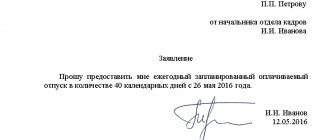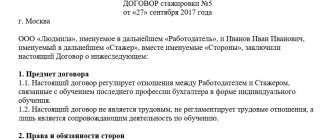In the work of an organization, sometimes it is necessary to deal with employees’ dishonest performance of their duties and violations of discipline. Such cases, of course, require some punishment for the offending employee. The procedure for applying disciplinary sanctions is prescribed in the Labor Code of the Russian Federation.
Many managers do not take the punishment system used in their organization seriously enough. Thus, often the punishment of guilty workers is subjective in nature, does not correlate with the severity of the offense committed, and does not take into account its circumstances. The application of such measures often does not comply with legal requirements.
Many organizations have a vague system of rewards and penalties that is not documented in any way. At the same time, punishments are imposed on personnel arbitrarily, “in words,” without proper formalization.
Moreover, some managers abuse disciplinary action to manipulate their subordinates. However, this is a big mistake. Any illegally applied punishment can be appealed by the injured employee and lead to extremely unpleasant consequences for the company’s management.
In what cases is disciplinary action applied?
The cases in which penalties are imposed are determined by Article 192 of the Labor Code of the Russian Federation. This is the failure or dishonest performance by an employee of his work. To do this, his duties must be specified in an employment contract or other document with mandatory familiarization with the employee’s signature.
Disciplinary action is applied:
- if the employee committed an action that was not permitted by work instructions or other regulatory documents;
- if the employee violated the job description or other norms of the organization (for example, did not fulfill direct duties or orders from management);
- if an employee does not comply with labor discipline (is late, absent from work).
Responsibility
Speaking about the penalties that await the employee if the commission makes an appropriate decision, their nature depends on the type of misconduct. The consequences may be frivolous, in the form of a reprimand or warning, or even leading to criminal liability.
From the perspective of labor legislation, a warning, reprimand and dismissal may be applicable to an employee who has violated the disciplinary procedure. Termination of an employment contract is not permissible from the first offense, with the exception of certain cases, for example, absenteeism.
Another type of responsibility is material. This involves recovery of damages caused by the employee. The procedure is also determined in accordance with the Labor Code of the Russian Federation (Article 248) and provides for the recovery from the employee of an amount not exceeding his average monthly earnings. If the damage is large, then it is possible to withhold money in several stages.
As a rule, only disciplinary measures are applied to the offender
If there is serious harm, the person responsible may be subject to criminal punishment. For example, causing harm to human health due to non-compliance with safety precautions. However, in such situations, the decision is made by the government agency.
How is a disciplinary sanction issued?
1. The fact of a disciplinary violation is documented. To do this, one or more documents from the following list are drawn up:
- act (for example, about the absence of an employee from work);
- memorandum (on violation of project deadlines);
- decision of the commission (conclusion of the audit commission on withholding the amount of the deficiency).
2. After a violation is recorded, it is necessary to obtain an explanation from the employee. This gives the employee the opportunity to indicate the reasons for his action. Failure to provide an explanatory note within two working days is recorded in a corresponding act.
It is better to formalize the employer’s request for explanations on paper and submit it against the employee’s signature. The employee’s refusal to sign the request is recorded in an act. A written request and a drawn up report on the absence of an employee’s explanation may be sufficient grounds for imposing a disciplinary sanction.
If the culprit provides an explanatory note on time, the employer makes a decision during its consideration. If the given reasons that led to the incident are considered valid, then disciplinary action may not follow. Otherwise, the note will become the basis for a penalty.
3. The next stage of formalizing a disciplinary sanction is the creation of an order. The manager decides independently which of the three punishments to use in each specific case, taking into account all the known circumstances of the offense, in proportion to its severity and consequences, and the guilt of the employee.
The order is prepared and submitted under the signature of the employee within three working days.
The order must contain:
- information about the employee, his position and place of work;
- the essence of the incident indicating the violated points of regulatory documents;
- a description of the violation with conclusions about the degree of its severity and the presence of the employee’s guilt;
- type of penalty imposed;
- grounds for recovery (details of documents in which the violation is recorded, explanations, acts).
If the culprit refuses to read the order and sign the document, a report is drawn up.
4. Making an entry in the employee’s personal file is optional. Information about the presence of a reprimand or reprimand can be entered in a personal card, but not in the employee’s work book.
Another comment on Art. 193 Labor Code of the Russian Federation
1. To understand the essence of the employee’s misconduct, the employer must obtain an explanation from him in writing. In the explanation, the employee must indicate the reasons for the offense and the circumstances under which it was committed. The employee may refuse to explain, which should not be considered an independent disciplinary offense, but may nevertheless affect the employer’s assessment of the employee’s personality. If the employee refuses to give an explanation, the employer must draw up a statement of refusal after two working days. This act must indicate the calendar date, place and reason for its preparation, as well as indicate the witnesses present when the employee was asked to provide an explanation and his refusal to do so. The act must be signed by an official of the employer and the witnesses present.
An employee’s refusal to give an explanation cannot be an obstacle to bringing him to disciplinary liability if there is other evidence of an offense (for example, memos from his immediate supervisor) and an act of refusal to give an explanation. They may provide documentary grounds for the application of disciplinary measures.
2. The educational value of a disciplinary sanction is preserved if it is applied directly after the commission of an offense. Therefore, the rule has been established that the penalty must be applied no later than one month from the date of discovery of the offense. The day of detection must be considered the day when the immediate supervisor of the violating employee became aware of it. In cases where there is a question of dismissal of an employee for committing theft (including minor) of someone else’s property at the place of work, embezzlement, intentional destruction or damage, the month period will be calculated from the date the court verdict or the act of the body authorized to do so enters into legal force. application of administrative penalties (for example, resolutions of an official of an internal affairs agency). The monthly period can be increased by:
- he is on vacation;
— necessary to take into account the motivated opinion of the elected body of the primary trade union organization.
The time of illness of an employee is understood as a period of temporary incapacity for work. The time spent on vacation should be understood as the periods of all vacations provided by the employer to the employee (including educational, in connection with pregnancy and childbirth, as well as those provided without pay). In accordance with the provisions of Art. 373 of the Labor Code of the Russian Federation (see commentary to it), upon dismissal for repeated failure by an employee who is a member of a trade union without good reason to fulfill labor duties, if he has a disciplinary sanction (see paragraph 5 of Article 81 of the Labor Code of the Russian Federation and commentary to it), the employer is obliged notify the elected body of the primary trade union organization so that the latter can assess the legality and justification of the upcoming dismissal. The elected trade union body, no later than seven working days from the date of receipt of the documents, reviews the submitted documents and communicates in writing to the employer its reasoned opinion on this issue (including the illegality or inappropriateness of dismissal). If you disagree with this opinion of the trade union committee, the employer has the right to terminate the employment contract with the employee no later than one month from the date of receipt of the reasoned opinion of the elected trade union body. This period can no longer be extended while the employee is ill or on vacation.
This is important to know: Collection of alimony for spousal support for up to 3 years: judicial practice
This tough position of the legislator and the judiciary is due to the need to protect the interests of the parties to the employment contract. Firstly, the effectiveness of any punishment depends on its efficiency and inevitability. Secondly, the employee should not be under the threat of disciplinary sanctions being applied to him for a long time.
In any case, disciplinary sanction must be applied no later than six months from the date of the offense, and based on the results of an audit, inspection of financial and economic activities or an audit - no later than two years. These deadlines can be extended only for the duration of the criminal case by the bodies of inquiry and investigation.
3. As a general rule, for each disciplinary offense, the employer can apply only one disciplinary sanction provided for by the Labor Code or the charters and regulations on discipline. Along with this, it is possible and necessary to simultaneously bring the employee to property (material - according to labor law) or civil liability in the event that his misconduct resulted in property damage. In this case, the rules and deadlines provided for by labor and civil legislation must be observed. In addition, along with disciplinary measures, disciplinary measures may be applied to the employee at the same time. For example, an employee may be reprimanded and deprived of a bonus for the period when labor discipline was violated.
4. As a general rule, the head of the organization exercises the full authority to apply disciplinary measures. At the same time, local regulations (orders of the manager, job descriptions or internal labor regulations) can redistribute the competence to bring employees to disciplinary liability between officials of the employer organization at various levels. Thus, the head of a workshop may be authorized to issue comments and reprimands to the workers of the workshop, and the head of a branch or representative office, on the basis of a power of attorney, may have full disciplinary powers, including dismissal of employees for violations of labor discipline. In some cases, the distribution of competence to apply disciplinary measures is carried out centrally. For example, the Charter on the discipline of crews of support vessels of the Navy provides that the commander of the ship (captain) can issue a reprimand, reprimand, severe reprimand and warn about incomplete performance, and an official who has the right to hire can exercise full disciplinary powers , - commander of a formation of ships or a military unit (clauses 15 and 16 of the Charter).
5. The order (instruction) on punishment is announced to the employee no later than three days from the date of publication against signature. This is necessary to confirm that the employee is familiar with the penalty applied to him. To optimize and record this procedure, it is advisable to include a note on the order (instruction) form itself indicating that the employee has familiarized himself with it. If the employee refuses to sign the acknowledgment, then an act is drawn up, similar in form and content to the act of refusal to give an explanation for the commission of a disciplinary offense (see paragraph 1 of the commentary to this article).
6. An employee may not agree with his being brought to disciplinary liability or with the type of penalty applied. In this case, he can appeal the employer’s actions to the state labor inspection authorities or labor dispute resolution authorities.
In accordance with the provisions of Part 2 of Art. 357 of the Labor Code of the Russian Federation (see commentary to it) in the event of an appeal by a trade union body, an employee or another person to the state labor inspectorate on an issue that is being considered by the relevant body for consideration of an individual or collective labor dispute (with the exception of claims accepted for consideration by the court, or issues on which there is a court decision), the state labor inspector, upon identifying an obvious violation of labor legislation or other regulatory legal acts containing labor law norms, has the right to issue an order to the employer that is subject to mandatory execution. This order may be appealed in court within ten days from the date of its receipt by the employer or his representative. Moreover, in accordance with the provisions of Art. 23.12 of the Code of the Russian Federation on Administrative Offenses The Federal Labor Inspectorate and state labor inspectorates subordinate to it are vested with the right to consider cases of violations of labor legislation and bring guilty employer officials to administrative responsibility.
Courts of general jurisdiction consider labor disputes related to bringing workers to disciplinary liability, both at first instance and by appealing decisions of the labor dispute commission and magistrates. In cases involving applications for reinstatement of an employee at work, courts of general jurisdiction are necessarily the first instance. Based on the results of the consideration of the case, the court makes a decision or issues a court order. In accordance with the provisions of Art. 211 of the Civil Procedure Code of the Russian Federation, a court decision or court order is subject to immediate execution if it is made on an application for payment of wages to an employee for three months and reinstatement at work.
Within what time frame can disciplinary action be taken?
In general cases, punishment is imposed within one month after the incident is discovered by the direct management of the guilty employee and no later than six months from the moment it occurred. The time an employee is absent for valid reasons is not included in this period. If a violation is identified during an audit or audit, this period is increased to 2 years. The time of production actions in a criminal case initiated on the basis of a violation is also not included in the total time of limitation of the offense.
The term for bringing disciplinary liability to an employee and the procedure for calculating it
The period for bringing disciplinary liability is the time period during which the employer has the right to apply penalties in the form of a reprimand, reprimand, or dismissal. The procedure for calculating this period is set out in parts 3, 4 of Art. 193 Labor Code of the Russian Federation.
The period for bringing to responsibility is 1 month from the moment the employer discovered the violation, but no later than six months from the moment the offense was committed.
For clarity, here are some examples:
Characters: director - Ivan Fedorovich; employee - Ilya Sergeevich; his immediate superior is Inna Aleksandrovna.
Situation 1: Ilya Sergeevich was late for work on 02/01/2017 by 15 minutes. The violation was recorded by Inna Aleksandrovna, writing a memo to director Ivan Fedorovich. However, I forgot to send the note, and only remembered about it on September 1, 2017 (7 months later). Having received the note, Ivan Fedorovich did not formalize the penalty against Ilya Sergeevich, since the period had expired - six months from the date of the violation.
Situation 2: Ilya Sergeevich was late for work on 02/01/2017 by 15 minutes. The violation was recorded by the director, Ivan Fedorovich, but he forgot to fill out the documents and bring Ilya Sergeevich to disciplinary liability. He remembered this only on 03/03/2017 (after 1 month and 2 days). Since 1 month had passed since Ilya Sergeevich committed the violation, the director realized that filing a penalty was illegal and did not do so.
How is a disciplinary sanction lifted?
The disciplinary sanction is canceled automatically or at the initiative of the employer himself. From this moment on, the employee is considered to have no penalties.
- The penalty is automatically lifted from the employee one year from the moment it was imposed in accordance with Article 194 of the Labor Code of the Russian Federation. The condition for automatic removal of the penalty is the absence of other violations during the year.
- The penalty can be canceled ahead of schedule with the filing of management. The employee himself or his immediate superior may request the termination of the penalty. If, while the penalty is in effect, the employee is transferred to another position, this will be sufficient grounds for termination of the penalty.
Early withdrawal of a penalty is formalized by an appropriate order, which is delivered to the employee against his signature.
Order of conduct
After completing the stage of organizing the inspection, when the violation is identified in the same way as the culprit of the incident, you need to move on to directly considering the issue and making a decision.
The procedure under consideration involves several mandatory steps, which include the following:
- Convening the commission. The manager must issue an order about this. By law, any employee can be a member of the commission. However, it is important to determine the involvement of other persons in the identified violation. Even if the audit is carried out in relation to one employee, there may be persons who in one way or another influenced the circumstances under consideration. When cases involve damage, an accountant is always included in the commission. In addition, the participation of the manager is mandatory.
- Consideration of the audit materials on their merits. Before moving on to the practical part, the manager had to prepare information about violations. Evidence, explanations, characteristics - all this will affect the commission’s verdict.
- Making a decision. This is formed by drawing up an act, which describes the progress of the investigation and the conclusion. The measure of influence on the employee is indicated; if damage is detected, then the method of covering it. The act is certified by the signatures of the commission members and the seal of the head.
The commission should include only disinterested employees - this is the only way the investigation will be objective
Note! Documents must be correctly prepared. Otherwise, even if there is evidence of guilt, the employee will be able to protest the act that does not meet the requirements.
How to properly apply disciplinary sanctions?
The application of disciplinary sanctions must be approached with full responsibility. This is especially true for such a serious penalty as dismissal. It is possible to dismiss an employee at the initiative of the employer only after a repeated violation with an existing penalty already in effect.
The employer needs to monitor the sequence of its actions. It should be remembered that one violation cannot be punished twice. If the latecomer has already received a reprimand, he cannot be reprimanded.
It is necessary to carefully prepare and execute all documents: both internal regulations establishing relationships with employees, and documents related to a particular case of disciplinary action.
Labor responsibilities must be assigned to the employee properly. If an employee has some new responsibility, it must be formalized. The employment contract, job description, local regulations, staff work schedule must be correctly drawn up and include a complete list of the employee’s functions. It is mandatory for the employee to sign that he has read this document.
Incorrectly drawn up labor regulations will certainly create difficulties if it is necessary to apply disciplinary action. The document must be drawn up in accordance with all the rules: indicating the name of the organization, familiarizing all employees with the presence of the necessary signatures and dates.
When preparing documentation in case of punishment of an employee, carefully check the availability of all the necessary papers: reporting and explanatory notes, orders to impose penalties, duty schedules and time sheets, and other documents. Check all signatures and dates on documents.
Issuing punishment
In order to fully comply with the procedure for applying disciplinary sanctions, you need to issue an order and familiarize the offender with it within three days. Sometimes an employee does not agree with the decision made and refuses to sign. His opinion does not affect the essence of the announced order; the employer simply draws up an act of refusal to familiarize himself with the document. The text of the order must include the reason, justification, date of discovery of the offense, and the grounds for imposing the punishment.
Sample order on application of disciplinary liability for failure to fulfill duties
What responsibility does the organization bear for violating the collection procedure?
Based on a complaint from a punished employee, a labor inspectorate may conduct an inspection to determine the legality of the disciplinary sanction and the correctness of its execution. In case of detected violations, the organization may be brought to administrative liability. In addition, a penalty that is groundless or applied in violation of the law is considered illegal.
In this case, the dismissed employee has the right to reinstatement through the court, to receive compensation from the employer for forced absence and for moral damage.
The employer will incur costs associated with legal proceedings, inspections by the labor inspectorate, the prosecutor's office, and will be forced to pay the costs of lawyers, and possibly a fine. The organization also risks damaging its business reputation and losing credibility among its own employees.
https://youtu.be/oxhuNl1XiSI
Organization of the procedure
To begin activities to verify the identified violations, it is necessary to establish their nature. The process of organizing an investigation will differ in the case of a disciplinary offense and material damage to the enterprise.
Article 192 of the Labor Code of the Russian Federation determines how to correctly conduct such an official investigation if a disciplinary offense has been established. The organization of events will involve the following:
- Obtaining explanations from the employee. Information must be recorded in writing. If a person refuses to write an explanatory note, then an act of refusal is drawn up.
- Making a decision on disciplinary action. This takes into account the employee’s explanation, the opinion of the immediate supervisor, as well as other information confirming the fact of the violation.
In this case, it is necessary to take into account the nature of the problem, the reasons for its occurrence and the circumstances under which the employee violated certain labor regulations.
It is imperative to obtain an explanation and reasoning from the employee about what happened.
When material damage is identified as a result of the unlawful actions of the perpetrator, the algorithm of actions will be as follows:
- Formation of the commission. There are at least three people there. In this case, any employee of the organization can consider the issue, with the exception of persons directly or indirectly related to the violation.
- Identification and investigation of circumstances. Determining the employee’s guilt and the reasons why the mistake was made.
- Making a decision. Based on the results of the investigation, an act is issued.
That is, at the stage of organizing an inspection, the management of the enterprise must obtain information about the problem and the circumstances surrounding its occurrence, so that in the future they can conduct an inspection and make a decision.
Note! Regardless of the nature of the violations, documentary evidence of them is required. Otherwise, the commission's decision can be challenged in court.









